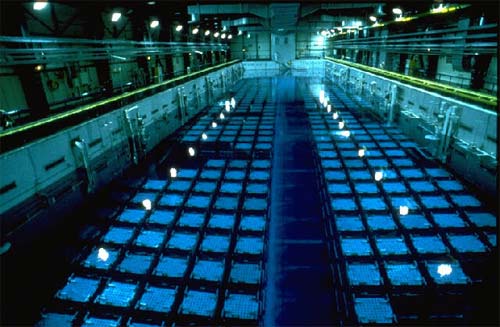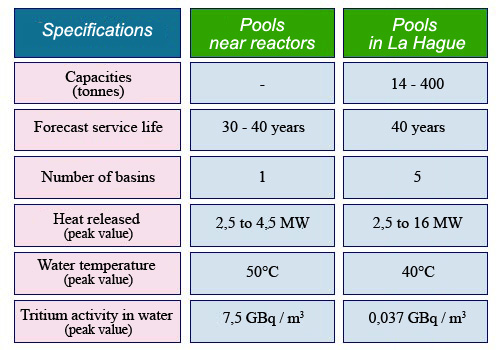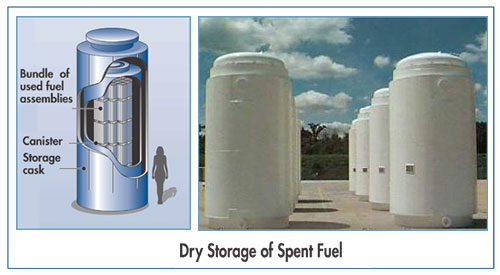Interim storage in pools and then dry locations

Large storage pool in la Hague plant
Spent fuel assemblies from French reactors are stored for at least five years in large pools at the La Hague plant until they are reprocessed. The pools at the plants in the Hague currently hold 7,500 tons of irradiated fuel, of which 7,000 are owned by EDF.
© AREVA/ Taillat (Jean-Marie)
In all countries, spent fuel management begins with a period in storage in a pool. A depth of a few metres of water is enough to protect against the extreme radioactivity emitted by fuel assemblies recently unloaded from the reactor core. Furthermore, water is resistant to radiation. It is an excellent coolant, able to absorb the heat released by fuel assemblies, which is initially very intense.
Fuel assemblies are unloaded from the core underwater, such that they are at no point exposed to the open air. The assemblies are stored in borated steel baskets in a pool located in the immediate vicinity of the reactor. (This pool is also used for loading operations). As unloaded fuel releases large quantities of heat, reactor cavity pools must be supplied with cool water. This feedwater is important when fuel has just been unloaded, as illustrated by the near-accident in Number 4 reactor cavity in Fukushima.

Spent fuel pool specifications
In France, spent fuel is stored underwater, initially near to the source reactors and subsequently in very large pools in La Hague, where fuel assemblies are centralised. The table contains basic specifications of these interim storage pools, their expected service life, the maximum heat released and the temperature and peak activity of the water. Pool water is filtered to trap radioactivity.
© IN2P3 (Source: RGN)
The aim of this precaution is to prevent any risk of criticality as although the fuel assemblies are spent, the fuel still contains more fissile uranium-235 (approximately 1%) than natural uranium. Neutron-absorbing boron is added to instantly shut down any incipient chain reactions.
The length of this initial storage period and the operations that follow it depend on the intended purpose of the spent fuel.
In a country such as France that has chosen to reprocess its fuel, this interim storage period may last between 1 year and 18 months, to allow radioactivity and heat release to decay sufficiently to allow the fuel to be transported to a reprocessing plant. In Japan, spent fuel is held in interim storage in reactor cavities for much longer periods, as became apparent in the context of the Fukushima accident. In Fukushima, the supply of cooling feedwater was interrupted for a few days. The reactor cavity at Number 4 reactor, which contained recently unloaded spent fuel from the reactor core as well as legacy fuel from previous loads, began to empty.

Dry storage casks in United States
The diagram on the left shows the dry storage concept used for spent fuel in United States. The photo on the right shows a series of storage casks at a reactor site. The necessary storage licences are issued by the Nuclear Regulatory Commission (NRC). This federal body is tasked with ensuring that facilities are safe, conducting inspections and enforcing safety regulations.
© NRC
Fuel assemblies that will be reprocessed are stored in very large pools after being transported to the plant in the Hague. Fuel is cooled in these pools for a minimum of five years. In practice, fuel spends eight years in these pools, on average. After this cooling period, the fuel is processed to recover the uranium and plutonium contained in it, and the residue is conditioned as vitrified waste.
Non-reprocessed fuel (350 tonnes out of an annual total of 1,200 tonnes) is also centralised and stored in these pools. EDF has stated its intention to reprocess this fuel at some stage in the future. MOX, which is more highly radioactive and is not cost-effective to reprocess, is stockpiled.
In countries that do not reprocess their fuel, fuel assemblies initially remain stored in pools. In the United States, they remain dispersed nationwide, stored near the 103 reactors that produced them. This interim storage has remained in effect for several decades.
Certain pools are full or nearly full. Due to the elapsed time, the heat released has decayed sufficiently (from 1,220 watts to 470 watts per fuel assembly after 5 and 35 years, respectively) to allow them to be cooled simply by circulating air. The oldest fuel assemblies were removed from the pools and stored dry, inside thick-walled casks that protect against radiation.
Sweden, which has only 12 reactors, has opted to centralise its fuel at a single site, and has built a large underground storage facility accprdo,gmy. Swedish fuel is earmarked for final disposal in a geological repository.
Germany is in an intermediate situation. Until 2005, Germany sent its spent fuel to La Hague for reprocessing, storing the vitrified waste subsequently returned to it. Since 2005, the country must also store its non-reprocessed fuel.
NEXT : Vitrified waste interim storage
Other articles on the subject « Waste management »
Waste management status
Repositories already in operation for low-level waste Compared with other types of waste, the mas[...]
Other storage facilities
Interim waste storage according to their nature and origin Spent fuel and vitrified waste from Pr[...]
Temporary storage
A temporary solution Interim storage is a temporary solution that plays a central role in the man[...]
Vitrified waste Storage
Dry storage of vitrified waste Spent nuclear fuel assemblies are not the only materials removed f[...]
Management outside France
Overview of waste management strategies outside France Management of the least radioactive waste [...]
LILW-SL waste repository
Disposal of low and intermediate-level short-lived waste Low and intermediate-level short-lived w[...]
VLLW repository
An operational repository for very low-level waste The second category of waste for which a repos[...]
High level waste transportation
Moving highly radioactive materials The 10% of transport movements that concern high-level radioa[...]
Transport safety
Measures to ensure safe transport Nuclear materials may be highly radioactive. The goal is to pre[...]
Transport-related incidents
Incidents but no accidents… Have radioactive material transport operations caused any accid[...]